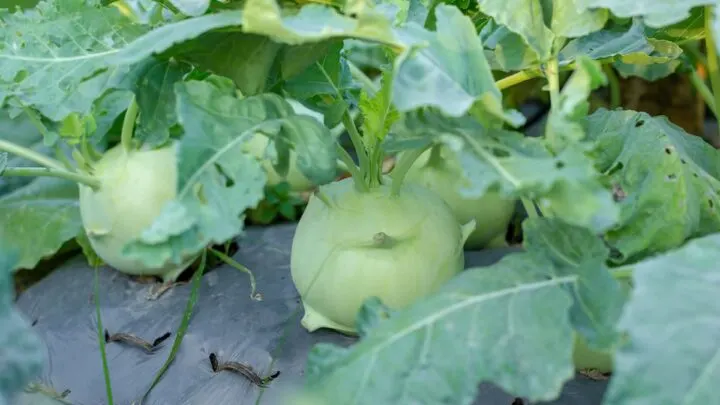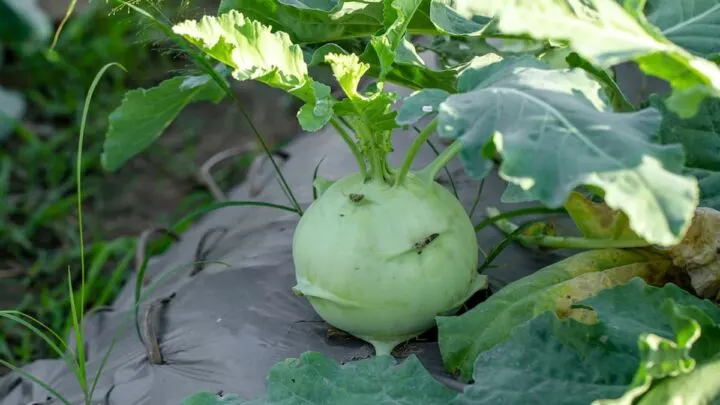Raw turnips and radishes can seem like similar vegetables, but they’re pretty different in how you should use them and how they cook up in food.
If you’re not sure which you want in your garden or how to tell these two root vegetables apart, we can help. We’ll cover the main differences in the taste and how you use turnips and radishes, and some of the differences in the garden.

Differences Between Turnips And Radishes
There are a few important ways to tell turnips and radishes apart, both when they’re raw and in how they taste and should be prepared. Here are some of the most important differences and how you can tell which vegetable you have.
These are essential things to know when you’re deciding which vegetable you want in your garden. Of course, you can also.
How To Tell Turnips And Radishes Apart
There are a few visible differences between fresh turnips and radishes.
For one thing, fresh turnips are significantly larger than radishes. A radish is going to be relatively small, the width of a quarter or two at most, while turnips can be the size of your fist and larger.
While both root vegetables are white in places, turnips tend to have a purple blush on the root, while radishes have a pink to reddish blush.
Both vegetables can have long trailing roots at the bottom of the main tuber, and in some cases, both vegetables may be available with leaves at the top of the tuber, so those aren’t reliable tell the difference. Focus on the size and color of the roots.
Lastly, and this can be a more subtle difference, radishes tend to feel harder in your hand, while turnips may have a slight softness. However, depending on how the vegetables have been treated and transported before buying them, this isn’t always a reliable difference either.
Taste Differences Between Turnips And Radishes
Both turnips and radishes can be described as zingy, slightly spicy vegetables raw, but radishes are significantly spicier, both raw and cooked.
Turnips mellow significantly more than radishes when cooked and can even become mild in flavor depending on how they are cooked. Creamy flavors are not uncommon in turnips, especially when cooked with butter or cream, while radishes are almost always going to have an acidic flavor and some spice heat.

How To Use Turnips
Turnips are a versatile vegetable suitable for cooking in soups, stews, and casseroles and can also be mashed as starch and served as a standalone side dish. In some cases, turnips can be seasoned and roasted, but that’s a little less common.
Turnips are rarely served raw and aren’t often used in salads. They’re a great winter vegetable but can struggle to find a home in dishes that are served cold.
How To Use Radishes
Radishes are similarly versatile but are used very differently than turnips. Radishes can be deliciously roasted with salt and herb seasonings, shredded or sliced to add to salads or soups and work as a vegetable side more than a starchy side.
Radishes also make a popular pickle and can be found pickled, raw, and cooked in a variety of east Asian cuisines and a wide variety of dishes.
Gardening Differences Between Turnips And Radishes
Now that you know a little more about how both vegetables are used and what kinds of dishes they’re popular in let’s look at how these vegetables are grown.

Turnip Gardening Basics
Here’s what you need to know about turnip gardening and how you can get a good crop of turnips.
Turnip Soil Requirements
Turnips need soft soil, but they don’t need very warm soil, unlike many other vegetables. They can grow well even in relatively cool temperatures and can be planted before the last frost for a late spring harvest, and you can continue planting through the summer and even autumn to get several harvests through the year.
Turnips should be planted directly in the ground or in a deep raised bed for the best results. The ground should be loosened to at least 15 inches deep and amended with 2-3 inches of compost, aged manure, or other organic-rich substance before each planting.
Mix fertilizers (12-12-12 fertilizer works well) and compost in about 12 inches before planting. Remember, turnips get most of their nutrition from the first time they are fertilized, and supplemental feeding doesn’t help nearly as much.
Planting And Turnip Care
Turnips grow quickly and can typically be planted from seed successfully while transplanting them can be more difficult.
Sew seeds roughly 1/2 inch deep in the ground to ensure enough light to help the seeds germinate. When the seedlings are roughly 4 inches tall, thin to plants at least 4 inches apart to make sure the turnips form properly and the tubers don’t get malformed while growing.
Turnips should be weeded thoroughly throughout the growing season and can benefit from mulch to help reduce weeds and retain moisture in the soil.
You should water roughly 1 inch per week to get good growth and stop the roots from getting overly tough or bitter. Watering can be split up between 1-3 times per week, with some extra water offered during the hotter summer growth period. Your goal is to allow the soil to dry to loose consistency before watering again, without letting the soil get too dry or keeping it wet too long.
You can harvest turnip greens separately from the turnip root, and they taste better when the turnips are young. Cut the greens off 2 inches above the soil and allow them to grow back (some turnips may not produce more leaves).
Young turnip roots are also often sweeter and milder and can be harvested as young as five weeks old. Turnips are often harvested up to 10 weeks after sprouting, and you can stagger planting to help get a continuous harvest throughout the growing season.

Radish Gardening Basics
There are two types of radishes depending both on when the radish is typically grown and when the radish grows best.
Spring radishes are fast growers and can be harvested in as little as a month and are typically planted in early spring for a late spring harvest. Spring radishes can be planted every ten days to continuously harvest through the warm months.
Winter radishes are better adjusted to cold temperatures, and you can switch to planting winter radishes in the early to late Autumn. Winter radishes grow more slowly, but they stay fresh longer after harvest and can stay in the ground longer without going bad or getting too woody to eat.
Radish Soil Requirements
Radishes are less picky than many vegetables when it comes to the soil they are planted in. They can use some fertilizer or compost before planting or once through the growing season, but they aren’t heavy feeders and don’t need particularly loose or dense soil either one.
The main requirement is that you should turn the soil before planting to make sure the radishes can grow roots freely and easily and that you should avoid both over-fertilizing and overwatering the plants.
Remember, radishes are fast-growing plants that don’t need a ton of water or food. They’re easy-care plants and mostly need to be protected from overcrowing and invasive weeds.
When choosing compost or fertilizers, aim for a blend that has more phosphorous and potassium than nitrogen. Excess nitrogen may make your radishes grow more leaves than radish roots.
Radish Planting And Care
Radishes can be planted from seed and should be sewn to roughly 1/2 inch depth for fast germination. They can be planted from early spring to mid-autumn, and winter varieties can be kept in the ground even though the first snow makes them ideal fresh winter vegetables.
Radishes should be planted every ten days for continuous harvesting or one month before you want to harvest.
Weed, pest, and disease management are the biggest challenges of radish care since the plants aren’t good at defending their plots against invaders. Weed thoroughly and often, particularly defending against weeds with large tap roots like dandelions and thistle.
Radishes can also attract several pests, so keep an eye out for aphids (which can be treated with insecticidal soap), snails and slugs (treated with snail treatments, wood ash, crushed egg shells, or used coffee grounds), and powdery mildew (treated with fungicide).
Covering your radishes with a tightly woven garden mesh can help prevent other insect invaders.
Additionally, you should rotate where you plant your radishes at least once every three years to help avoid deeper soil pests and diseases.
In most cases, radishes are disease hardy. However, if you harvest radishes that have turned black or are misshapen, especially if the problem occurs in several plants, it’s best to change where you’re planting your radishes for your next planting.

Hi there, my name is Allie and welcome to my blog; GareningWithAllie!
Much of what you see written here is just our personal experiences with gardening. Along with the content I write here, there is also a unique collection of gardening topics covered by some of our close friends. I hope you find everything you read here to be helpful, informative, and something that can make your gardening journey the most lovely experience ever! With that said, Happy Gardening!
